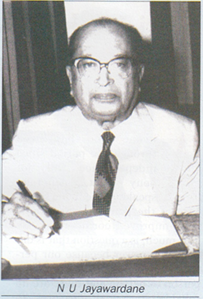The gross national income of Sri Lanka soon after Independence was Rs 282 per head per annum (equivalent to US$59 per head at the then prevailing exchange rate and corresponding to Rs 3,189 at 1995 values).”- JR Jayewardene, 1948.
However, 47 years later in 1995, the GDP of Sri i Lanka (at market prices) was Rs.36,357 per capita, per annum, equivalent to US$709 at prevailing values. Accordingly, over 47 years, the gross national income in the US dollar terms has increased twelve fold, implying an annual low growth rate over the period, of nearly 1.7% per annum compounded.
In contrast, East and South East Asia have been able to surpass Sri Lanka by leaps in performance from deliberate growthfriendly policies.
The rise in per capita income was due to accelerated economic growth rates during 1985-93 (and continued into 1995), averaging 9.2% for China. 9.1% for Thailand, 7.8% for Singapore, 7.4% for Malaysia, 6.4% for Indonesia, 5.5% for Pakistan. 1.8% for India and a respectable 4.1% for Sri Lanka and Bangladesh.
The reasons for Sri Lanka lagging behind other East and South East Asian countries were graphically expressed by the celebrated Cambridge economist. the late Joan Robinson in a paper she contributed in the late fifties that Ceylon followed a policy mix aimed at ‘tasting the fruit before it grew the tree’, and this tendency has been the bane of Sri Lankan politics over the years with occasional interludes.
It was Sri Lanka’s great misfortune that in the critical years of its political development, the country should have experienced two distinct and discordant forces, One was the advent of forceful and radical groups bred in communism and its variant of Marxist ideology and tradition who were genuinely convinced that the socialist millennium could replace the economic organisation of emerging capitalism m Sri Lanka. The other was the understandable concern of the minority group of the Sri Lankan Tamils, who were understandably unable to reconcile themselves to the inevitable consequence that, with the progress of political reform, the dominance they had exercised had necessarily to slip from their grip.
Their sense of insecurity and loss of dominance were aggravated by the thoughtless action of the majority Sinhalese community.
In relation to the first concern, it transpired that even those in political authority both in the immediate pre-Independence and post-independence regimes, were compelled to attune their policies to the growing influence of the merging combative radical forces, led by outstanding intellectuals of great organising ability, enabling them to execute a range of measures destructive of the economic base of the country. As a result, it experienced the worst of both worlds; it was denied both the materialist incentive of capitalism as well as the humanist urge of communism and variant socialism.
In Sri Lanka, the impact of these radical forces was disastrous on its growth effect. Policies were motivated by political and ideological reasons, as a deliberate reaction against established regimes. These included, in the first phase, in the late fifties, the nationalisation of transport, insurance, plumbago mining and liquor business as a pique against the supporters of the previous regime, identified as capitalist. These measures were followed by succeeding political regimes with a pronounced socialist bent in the takeover of plantations, containing the core of the organised agricultural industry, first those nationally owned, and next those foreign owned. The combined result was the untold disastrous impact caused by overmanning and poor management under political patronage, on productivity, profitability and competitiveness of what was, and still is, a major segment of the agricultural industry of the country and a significant component of the national economy.
Other socialist measures were the nationalisation of port operations, in particular, Colombo Port, which has contributed to excessive employment at all levels on an unparallel scale. The political patronage. undermined the Colombo Port in its development as a hub-port of the region, and undermined expansion of the Galle Port to avail of its strategic location on the sea-routes skirting the south.

In the name of socialist ideology, other measures enforced were limitation on owning of houses to encourage broad-based house-ownership land, the Acquisition of the Business Undertakings Act, exerting A contiming threat to every politically unacceptable private enterprise, and the Termination of Employment Act. Complementing these policies was the proliferation of state-owned entities. Added to these disabilities is a labour market prone to worker indiscipline t often inspired by political patronage and supported by d worker organisations which confuse freedom with license. The end result 13 that business risk is unavoidably enhanced, investment is discouraged and enterprises thwarted. In this scenario, to expect sustained economic growth is to entertain a delusion.
The only purposeful development which materialised in the immediate pre-Independence era was the determined efforts by DS Senanayake, the Minister of Agriculture with his son, Dudley, as the succeeding of Minister of Agriculture, to win the jungle tide of the Malaria- ridden Dry Zone, centering round Minneriya and Kantalai and, after Independence, the successful assault on the vast hostile jungle forming the basin of the celebrated Gal-Oya Scheme.
Little else was done to develop other resources in Agriculture or industry beyond sporadic attempts at misconcerned import substitution at high cost, and the negative impact of assorted schemes of nationalisation eroding the economic base of the nation.
In this depressing gloom, one episode stands out when the redoubtable G G Ponnambalam became Minister of Incustries, supported by an uncommon Civil Servant with a pronounced inmorative bent. D H Belfour, who pioneered several industries, some good. but several short-lived. Of these four stand out! The Cement Factory at Kankesanturai with its still high development potential but located in what became a terrorist zone: Pullmodai Mineral Sands which should have been developed into downstream manufacturing facility, Paranthan Chemicals which never progressed beyond its initial stage and Ceramic Ware, based on exceptional kaolin deposits, but it more recently no poor technology and weak organisation. A sector waxed and waned in varying phases was the handloom industry. It had and still has the potential of high profitable growth, if only it could access, on an adequate scale, high technology, innovative designs and efficient marketing.
A resurgence occurred after 1977 with the advent of market-friendly policies. The development prospects of Sri Lanka are vast. The simple reason is that there is no country in the South and East Pacific region of the small, compact size of Sri Lanka, with an admirable range of climatic features, where two-thirds of the land hold one-third of the people, availing systematic development in a variety of fields, capable of yielding high product value, and inhabited by a people with high literacy and equally high life expectancy, provided certain conditions prevail;
(1) Separatist and fissiparous tendencies are replaced by harmonius relations among all communities.
(2) Exceution of sound, macro economic policies supportive of the required development effort, but without becoming the victim of political rhetoric.
(3) Total reform of the fiscal system and so designed to encourage private effort. saving and investment in a low-tax regime, with a parallel effective programme to combat and eliminate the “black economy”, which can seriously distort economic values, corrupt political behavior and grievously tarnish social conduct.
(4) Acceptance of the role of banking and finance in contributing to economic growth in functioning as:
(a) a catalyst of enterprise and (b) the life stream of the economic process..
On this premise banking and financial services in the variety of their forms and their evolving new products should be totally exempted from tax impositions. There are different and better ways of recovering such lost revenues. Indeed, it is important to develop a new culture in appreciation of the strategic role of banking, and finance has a service in the development process.
(5) Fortunately, those currently in governance of the Central Bank, unlike in the two previous regimes, can be trusted to assume this pivotal role with imaginative discretion, provided they can summon the necessary competent staff and also secure the required political will. An important component would be an autonomous National Information Commission. as a constituent of the six Institutional Pallors Symbolic of the Sovereign Will of the People, in any Reform Constitution.
In this scenario, it is not over optimistic to contemplate that Sri Lanka in the dawn of the 21st Century can confidently expect a regime of sustained and accelerated economic growth and so escape from the
subsisting poverty trap, itself a product of a short sighted and populist policies to which many political regimes in governance from Independence, as well as other radical parties out of power, for command or ideological reasons have indiscriminately contributed.



